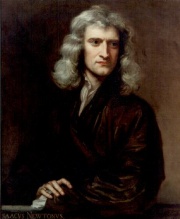Isaac Newton - работа с текстом
Level – Intermediate and above
Skill – Comprehensive Reading
Ex.1 Read the text to get the main idea.
The great English scientist Isaac Newton was born on December 25, 1642 not far from the university town of Cambridge. In 1661 Newton entered the University of Cambridge where he studied mathematics. When Newton was twenty-two years old he began studying the theory of gravitation. In 1665, while he was on a visit to his native village, he saw an apple fall from a tree and began wondering what force made the apple fall.
Newton worked out the methods of calculus. He performed many experiments with light and found that white light was made up of rays of different colours. He invented a reflecting telescope that was very small in diameter but magnified objects to forty diameters. Newton developed a mathematical method which is known as the Binomial Theorem and also differential and integral calculus.
In 1669 Newton was appointed professor and began lectures on mathematics and optics at Cambridge and continued his work on the problem of gravitation. In 1673 Newton completed his theory. By examining the attraction of one mass by another Newton treated the problems of the sun, moon and earth like problems of geometry. The proof of Newton's universe square law was not complete. His great work "Elements of Natural Philosophy" was published in 1687.
Newton's law of universe squares joined in one simple mathematical statement the behaviour of the planets as well as of bodies on this earth. It was the first synthesis of physical knowledge. Newton's contribution to science is unique.
Isaac Newton died at the age of 85. He was buried with honours as a national hero. It was the first time that national honours of this kind had been accorded in England to a man of science.
(The text is from the book ‘120 Topics’ by A.P. Miniar-Belorucheva, Moscow, 2007)
2. Read the text once more, cover it and then in groups of three try to fill in gaps.
The great English scientist Isaac Newton was 1_____ on December 25, 1642 not far 2______ the university town of Cambridge. In 3______ Newton entered the University of Cambridge 4_____ he studied mathematics. When Newton was 5_____ years old he began studying the 6_____ of gravitation. In 1665, while he 7_____ on a visit to his native village, 8____ saw an apple fall from a 9____ and began wondering what force made 10_____ apple fall.
Newton worked out the 11______ of calculus. He performed many experiments 12______ light and found that white light 13____ made up of rays of different 14_____. He invented a reflecting telescope that 15_____ very small in diameter but magnified 16______ to forty diameters. Newton developed a 17_____ method which is known as the 18______ Theorem and also differential and integral 19______.
In 1669 Newton was appointed professor 20_____ began lectures on mathematics and optics 21_____ Cambridge and continued his work on 22_____ problem of gravitation. In 1673 Newton 23______ his theory. By examining the attraction 24____ one mass by another Newton treated 25____ problems of the sun, moon and 26______ like problems of geometry. The proof 27_____ Newton's universe square law was not 28_____. His great work "Elements of Natural 29______" was published in 1687.
Newton's law 30____ universe squares joined in one simple 31_____ statement the behaviour of the planets 32_____ well as of bodies on this 33______. It was the first synthesis of 34______ knowledge. Newton's contribution to science is 35______. Isaac Newton died at the age 36_____ 85. He was buried with honours 37_____ a national hero. It was the 38______ time that national honours of this 39______ had been accorded in England to 40____ man of science.
3. Correct the statements:
- In 1661 Newton entered the University of Oxford where he studied mathematics.
- When Newton was twelve years old he began studying the theory of gravitation.
- He invented a reflecting telescope that was very large in diameter but magnified objects to a hundred diameters.
- The proof of Newton's universe square law was complete.
- He was buried quietly.
- It was the fourth time that national honours of this kind had been accorded in England to a man of science.
4. Try to remember as much as possible information using these figures.
December 25, 1642
1661
1665
1669
1673
1687
the age of 85


